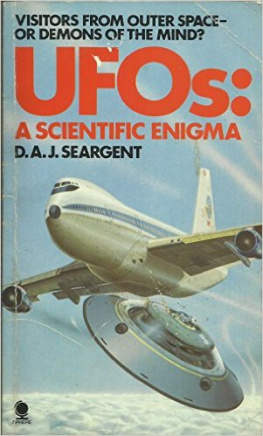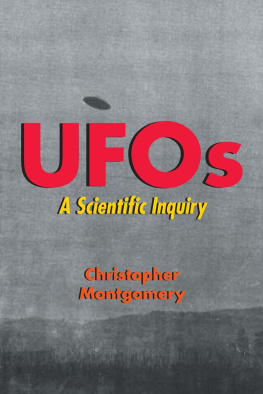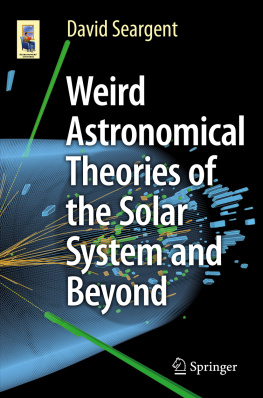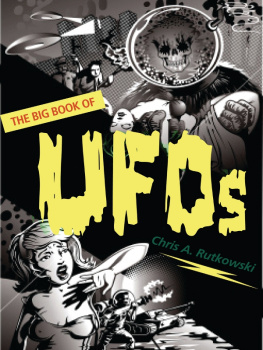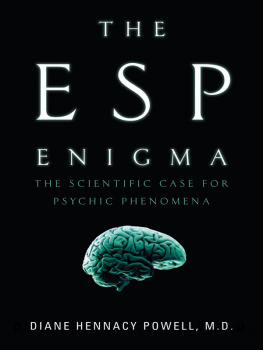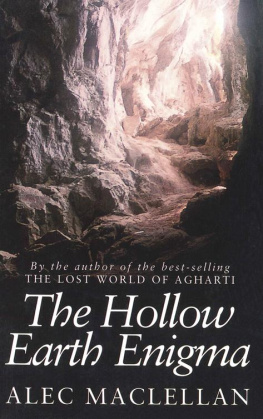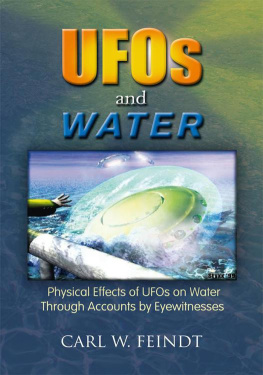D.A.J. Seargent - UFOs: A Scientific Enigma
Here you can read online D.A.J. Seargent - UFOs: A Scientific Enigma full text of the book (entire story) in english for free. Download pdf and epub, get meaning, cover and reviews about this ebook. year: 1978, genre: Religion. Description of the work, (preface) as well as reviews are available. Best literature library LitArk.com created for fans of good reading and offers a wide selection of genres:
Romance novel
Science fiction
Adventure
Detective
Science
History
Home and family
Prose
Art
Politics
Computer
Non-fiction
Religion
Business
Children
Humor
Choose a favorite category and find really read worthwhile books. Enjoy immersion in the world of imagination, feel the emotions of the characters or learn something new for yourself, make an fascinating discovery.
- Book:UFOs: A Scientific Enigma
- Author:
- Genre:
- Year:1978
- Rating:3 / 5
- Favourites:Add to favourites
- Your mark:
- 60
- 1
- 2
- 3
- 4
- 5
UFOs: A Scientific Enigma: summary, description and annotation
We offer to read an annotation, description, summary or preface (depends on what the author of the book "UFOs: A Scientific Enigma" wrote himself). If you haven't found the necessary information about the book — write in the comments, we will try to find it.
UFOs: A Scientific Enigma — read online for free the complete book (whole text) full work
Below is the text of the book, divided by pages. System saving the place of the last page read, allows you to conveniently read the book "UFOs: A Scientific Enigma" online for free, without having to search again every time where you left off. Put a bookmark, and you can go to the page where you finished reading at any time.
Font size:
Interval:
Bookmark:
By
D.A.J. Seargent
Copyright: 1978
Mankind has always enjoyed a good mystery, something which opens the door into a realm beyond the mundane; a realm wherein may lie all manner of mysterious and mind-boggling entities. Tales of the supernormal never fail to appeal and there is within most of us a secret wish that at least some of these far-fetched stories may possess a kernel of truth.
The UFO mystery, therefore, could not fail to exert a powerful and widespread appeal. Here is something stepping straight from the pages of the wildest science fiction directly into reality - or so it seems to many people. Needless to say, books sounding more like science fiction than anything purporting to be factual have been presented as sober fact, and have proven extremely popular because of this. Likewise, a host of new religious cults have sprung up, basing their beliefs upon messages allegedly received, by chosen individuals, from a kindly race of spacemen - pilots of flying saucers which are what UFOs really are.
On the other hand, an equal and opposite reaction has developed, often assisted by the same kind of emotive reaction which is seen among the believers. It is as if questions about the existence of UFOs, like questions concerning religious topics, divide people into two sharply opposing camps the believers and the non-believers. The parallel with religious questions should be borne in mind; both touch on the existence or non-existence of something extra-mundane and it seems to be the willingness or otherwise to admit to something over and above the everyday world which arouses, more than anything else, people's deepest hopes and fears.
This present work, hopefully, steers a middle course. It is not intended to comfort those who are feverishly searching for evidence that will make belief in flying saucers scientifically respectable, but neither is it a negative work designed to assist the scoffer in his non-belief. There are sufficient books available for either class of reader. The present book is for those who suspend belief and disbelief alike until sufficient evidence has been amassed and analysed to allow either affirmation or rejection to be rational assent or non-concurrence rather than emotional belief or disbelief.
The UFO problem will be treated in the manner of any unsolved puzzle, i.e. as a problem which may have a solution within the framework of scientific knowledge (already acquired or yet to be acquired), and not as a mystery upon which we may only look and wonder.
However, this is not to dogmatically affirm that science, still less physical science, holds a ready answer to the problem. Neither is it to say that the problem must be reduced to some-thing mundane. There may well be genuine 'new empirical information' (in Professor Hynek's words) encountered in UFO phenomenon and, if this is true, science and even our conception of the universe itself may be in for some very rude shocks. It may even be discovered that the scientific explanation confirms the cultist's beliefs, or that the phenomenon is found to involve something far more revolutionary than even the wildest cultist had ever dreamed. We shall just have to wait and (hopefully) see.
In the chapters which follow I shall attempt to present the UFO as a phenomenon to be studied. That is to say, I shall keep preconceived ideas about the nature of the phenomenon to a minimum and concentrate on what we know, or what we think we know, about these strange apparitions, thereby building up a picture (albeit a sketchy one) of the real, or, at least, the reported-as-real, UFO whereby the various speculations concerning the nature of the phenomenon can be tested.
In the true sense of the term, therefore, I hope this will be a 'scientific' book about UFOs.
D.S.
~~~~~~~
When early Man looked up into the great dome of sky above his head and first took notice of the myriad lights suspended there, his experience must have been one of total bewilderment; bewilderment reflected today in what we call the UFO experience. In other words, for early Man, everything in the sky was a UFO he could not identify anything in that mysterious great vault which seemed so different, so utterly alien to the features of his normal, everyday world. Surely the sky must be the realm of supernatural beings - god who could hold back or give the life-giving rain, who controlled and wielded the lightning and thunder, and whose friendship Man so eagerly desired.
Thus, Man started his history surrounded by UFOs and supernatural beings, and the progress of science has seen the gradual elimination of these UFOs and their transference to the class of IFOs (Identified Flying Objects). We know now what the sun is and what the moon is. We know much about the nature of the stars and even those most mysterious of objects, the comets, are at last being made to conform to the scientific picture of the world. What is left up there in the vault of sky that the common man sees but cannot identify? What remains of the cast population of UFOs? Does anything remain of the mystery? Are there still rogue phenomena which do not fit into our scientific world-view? Or is everything now, at last, accounted for?
Many people would like to believe that everything is now accounted for. That our little minds now stand within reach of knowing everything, but others maintain a realistic doubt. These latter believe that some of the lights and objects seen in the skies are not yet within the realm of our understanding; that, in other words, there still remains of the vast former population of unidentified objects a small remnant to which the term 'UFO' - unidentified flying object - may still reasonably be applied.
Frequently, weird explanations and fanciful theories have been put forward in what may seem a desperate attempt to bring these rogue objects within the orb of science. Equally, some fantastic attempts have been made to identify them with some known and well-established scientific phenomenon. Yet, with all this theory and counter-theory, we are still left with a great question mark. It is with this question mark, and the hope of erasing same, that we are now concerned.
If there are UFOs, if there are still things floating around above our heads which we cannot bring under the blanket of our present-day scientific knowledge, they must, presumably, have certain features which differentiate them from those things in the sky which are known to us, and these features should facilitate the recognition of these rogues both in reports of the present day and in the accounts of ancient times, assuming that the present-day rogues are not some new phenomenon which was non-existent in former ages.
The existence or non-existence of the present-day types of UFO in earlier epochs may be clouded somewhat by the fact that most of the things which we now treat as quite commonplace were equally UFOs then and were equally likely to generate fanciful reports and theories. Comets are an especial case in this regard, as the early accounts of these objects prove. Sifting out UFOs, in the present-day sense, from all these other phenomena is not an easy task, and many accounts which appear similar to the modern UFO reports may, in fact, be reports of such easily identifiables (by present-day standards) as comets and aurorae.
The converse, of course, may also be true. For instance, the following ancient Roman report has, been preserved for us by Chambers and included by him in a catalogue of comets com
piled in the latter part of the last century. The report states that (in the year 75 BC) 'A spark fell from a star and grew larger as it approached the earth to become as large as the moon and as bright as the sun on a cloudy day. On returning to the sky, it took the form of a torch.' This could really be a fanciful account of a comet, but there are certain odd features about it. For instance, translated, the word 'torch' in Roman chronicles refers to a class of object which, although often associated with comets by modern historians of astronomy -including Chambers, was specifically distinguished from comets by Pliny. Presumably 'torches' were bright meteors of the type we would now term 'fireballs' or 'bolides'. Not a few may have been meteorites.
Font size:
Interval:
Bookmark:
Similar books «UFOs: A Scientific Enigma»
Look at similar books to UFOs: A Scientific Enigma. We have selected literature similar in name and meaning in the hope of providing readers with more options to find new, interesting, not yet read works.
Discussion, reviews of the book UFOs: A Scientific Enigma and just readers' own opinions. Leave your comments, write what you think about the work, its meaning or the main characters. Specify what exactly you liked and what you didn't like, and why you think so.

